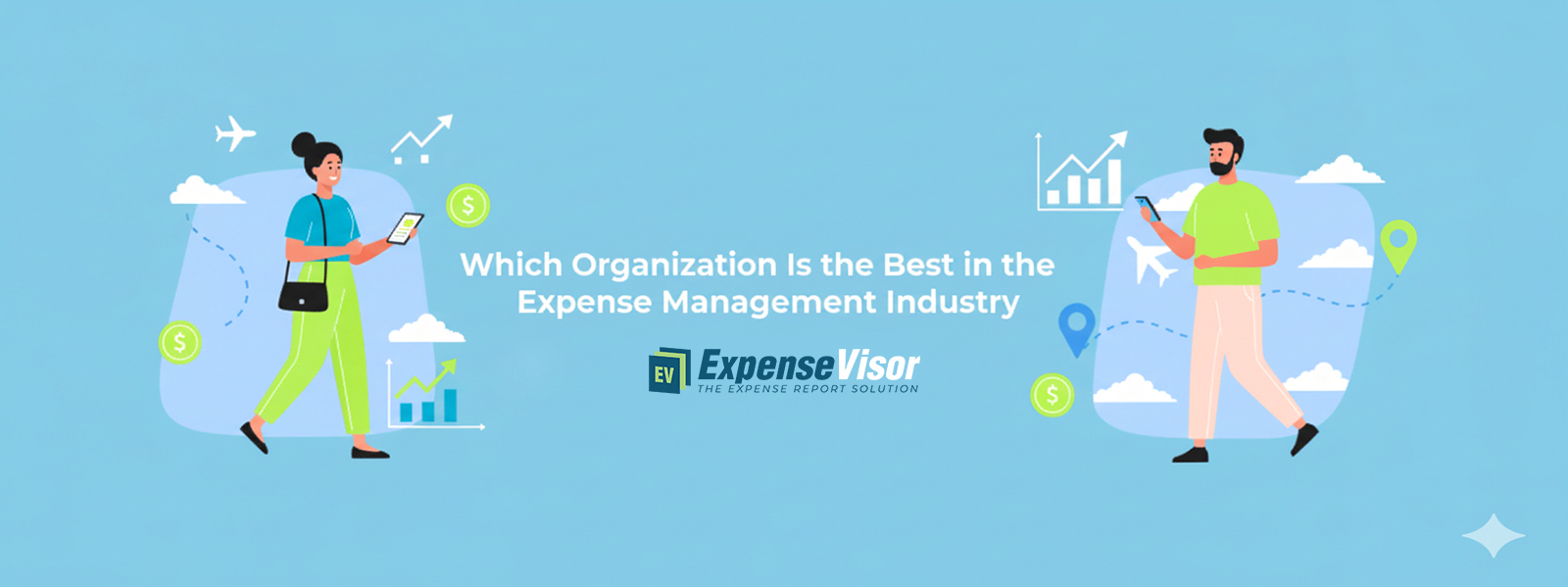Did you know? Most OCR tools get receipts scanned right only about 85% of the time. This means errors are bound to happen if you rely on OCR technology for receipts alone. As per McKinsey, companies that use AI-powered receipt scanners noticed up to 90% fewer data-entry mistakes, which puts a major boost in accuracy and speed. Especially, if businesses rely on legit travel expense software like ExpenseVisor, they can witness up to 100% accuracy in their finances.
Now, imagine businesses handling expenses without such tools. Slips piled up, manual entries take up to hours, missed digits and small mistakes causing huge blunders. It can also result in budgeting errors and even tax troubles. Without digital receipt scanning and expense automation, finance teams end up losing valuable hours. They waste time chasing receipts, correcting entries and verifying claims, which leaves less time for actual tasks that matter.
This blog will give you a complete overview of receipt scanners, including:
- What is receipt scanning
- How digital receipt scanning works
- Core technologies behind the receipt scanner accuracy
- Key considerations while picking a receipt scanner
- How ExpenseVisor ensures receipt scanner accuracy
What is Receipt Scanning?
Receipt scanning means turning physical receipts into a digital format through a simple click. The process begins by capturing an image of the receipt and uploading it to the software. Technologies like OCR and AI come into the picture. OCR recognises and extracts information from scanned images. On the other hand, AI improves the categorisation of receipts, identifies mistakes and flags potential fraud.
With digital receipt scanning, a business can enjoy paperless expense management with zero risks of errors or fraud. This improves the overall financial efficiency of a business and reduces the chance of losing important financial data.

How Digital Receipt Scanning Works?
Want to digitise expense automation? We have listed some practical and proven methods below that you can rely on for digital receipt scanning and expense automation:
Receipt Scanner App
A receipt scanner app is the #1 choice of any business looking for efficiency and a hassle-free process. These expense automation apps use OCR technology for receipts to draw out information like totals, vendor names and tax details from the image. Most travel expense software, like ExpenseVisor, has modern features like direct syncing with accounting tools, auto tagging and cloud-based backups for paperless expense management.
Many apps support multiple languages and currencies, making them ideal for freelancers, startups and international travellers. With features like built-in expense automation, you can generate and sync expenses to travel expense software easily. It’s like killing two birds with one stone, i.e. scanning and organising in one go.
Scanning on a Desktop
Desktop scanners are considered an old-school method, but they are still preferred for reliable digital receipt scanning. With high-resolution output, they capture crisp images that can be stored for audits or compliance needs. Several desktop models have auto-feeders that let you scan large stacks of receipts in one go, saving time for accounting teams.
Moreover, when paired with document management software, these scanners boost receipt scanner accuracy by cleaning up poor-quality images and improving faded text. While it is less portable, desktop scanning is like having all your ducks in a row when it comes to archiving receipts in bulk.
Smartphone Camera Scanning
If you are looking for a handy choice, nothing beats smartphone camera scanning! It offers quick, on-the-go capturing that makes digital receipt scanning as easy as clicking a picture. Many innovative travel expense software auto-crops, fixes alignment and applies OCR instantly to turn photos into usable data.
The best advantage? Portability! Professionals who are frequent flyers can capture and upload receipts on the move. This makes travel expense software integration effortless.

Core Technologies Behind Receipt Scanner Accuracy
Curious to know what makes digital receipt scanning effortless and boosts receipt scanner accuracy? Below, we’ve listed some effective methods that will give you complete knowledge about the core technologies behind receipt scanner accuracy:
OCR Technology for Digital Conversion
OCR technology for receipts is the backbone of digital receipt scanning. The process works by scanning an image of a paper slip, identifying text and converting it into machine-readable data. It captures information like date, vendor name, amount and tax information. This makes receipts searchable and editable.
Smart OCR systems use image enhancement techniques like text sharpening, de-skewing and noise removal to improve accuracy even on faded or crumpled receipts. Latest digital receipt scanning software like ExpenseVisor uses modern OCR that can read complex layouts and even handwritten text, which improves overall results.
AI for Categorisation and Analysis
While the OCR role is to extract raw information, AI-powered digital receipt scanning takes the next step by analysing and categorising data. It categorises the extracted information and tags expenses like travel, meals and office supplies. AI can also identify anomalies, spot duplicate slips and improve accuracy with every new scan. AI play a key role in making paperless expense management effortless.
The process improves expense automation by reducing the need for manual checks. For example, instead of an accountant sorting through hundreds of receipts, AI can instantly generate structured reports and sync with accounting software or travel expense software.
Cloud-Based Solutions for Storage and Management
After receipts are captured, scanned and categorised, the next step is to store and manage them securely. Cloud-based solutions take over this part by uploading scanned data to an online, secure platform. Receipts can be accessed from any part of the world.
The step ensures receipts are not just stored but integrated with financial tools as well. Finance teams collaborate in real-time, and management can review expenses any time without needing physical slips. Cloud storage also enables paperless expense management, saving space, reducing costs, and simplifying audits.
Key Considerations While Picking a Receipt Scanner
Choosing the right receipt scanner can make or break your digital receipt scanning workflow. To ensure seamless expense automation and unmatched receipt scanner accuracy, here are a few factors you need to keep in mind:
AI-Driven Accuracy
To ensure high receipt scanner accuracy, opt for scanners that use AI and OCR technology for receipts. That’s because machine learning models can identify details that traditional OCR might miss, like messy layouts, damaged paper or faded text. AIs help reduce errors, keep finance data reliable and call for the least human error. After all, why let errors slip through the cracks when technology can catch them in seconds?
Multi-Language & Multi-Currency Support
If your business deals with clients across the globe, multi-language and multi-currency recognition shouldn’t be left to chance. It makes sure receipts from all global vendors are scanned without confusion. Be it Dollars or Euros, a scanner must be capable enough to keep your costs aligned with 100% accuracy.
Batch Processing
Companies that deal with heavy receipt loads should consider scanners with a batch processing feature. It is a lifesaver. Why? Because instead of scanning receipts, one by one, with batch processing, you can process slips in groups, saving enough time, hassle and energy. Batch processing benefits accounting teams the most as they can keep their system updated with no backlog.
Mobile App Support
Since modern businesses are always on the move, they need a reliable mobile app that lets employees snap slips anytime, anywhere and report expenses in real-time. Consider choosing a scanner that allows you to click and share expenses digitally within a few clicks. Paired with travel expense software, mobile scanning ensures no slip is lost in the shuffle.
Cloud Storage
Cloud storage adds a strong layer of backup, so you never put all your eggs in one basket. Opting for a cloud-enabled scanner means having your receipts stored in centralised storage that can be accessed by teams across locations. Not only does this provide a strong backup, but remote workers, accountants and managers can view receipts without any delay.
Seamless ERP and Accounting Software Integration
A reliable scanner must plug directly into financial systems. With this integration, receipts directly flow into systems, cutting out the chance of duplicate entry. This kind of link between scanning and software ensures expense automation flows smoothly across departments.
Data Formats and Export Options
Compatibility matters. Scanners should allow exporting in formats such as CSV, XML, or JSON so that data can move easily between platforms. This flexibility keeps reports consistent and makes collaboration effortless. In short, the right export features ensure you’re not stuck trying to fit a square peg in a round hole.
How ExpenseVisor Ensures Receipt Scanner Accuracy
ExpenseVisor supercharges your digital receipt scanning and expense automation, making it a breeze to go paperless and keep your finances in check. With its powerful OCR technology for receipts, it captures every detail such as date, vendor, and totals in a snap, ensuring receipt scanner accuracy that works in real business settings.
Its smart features like automated approval workflows, seamless integration with accounting tools, and real-time syncing with travel expense software mean you spend less time wrestling with spreadsheets and more time focusing on growth. Whether you are managing travel costs or aiming for efficient paperless expense management, ExpenseVisor has you covered. Ready to see it in action? Contact us today and take your expense tracking to the next level.



